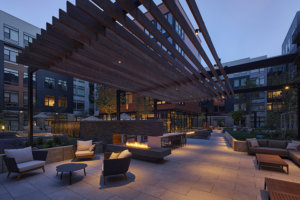Outdoor gathering spaces have surged in popularity in the U.S., especially in the wake of COVID. While the concept of a town square or plaza is hardly new, particularly in Europe – cobbled piazzas have been the heartbeat of Italian towns for centuries – creating dynamic, modern outdoor spaces requires thoughtful design and planning. Proper lighting design can elevate these spaces and make them feel like intimate, open air living rooms, a particularly important goal in the era of social distancing.
“The idea of making outdoor spaces feel more like the indoors was definitely amplified by COVID,” explains Jered Widmer, Principal. “People are looking to connect with one another while social distancing in the fresh air. A lot of developers, owners and cities are rethinking their public spaces and how to make them more impactful. Cities have closed streets and installed planters and outdoor seating. We’re repurposing our outdoor spaces to bring people together in a safe way and allow businesses to thrive.”
Creating a More Flexible Outdoor Space
As Americans gather outside more often, public spaces need lighting that adapts to different occasions and seasons. Stringing festoon lights overhead may be the classic solution to create a warm, twinkling atmosphere, but they don’t provide much flexibility.
“We’re tailoring our lighting solutions to be much more adaptable,” shares Widmer. “No matter the region – whether you’re in the snowy Northeast or sunny Florida – people enjoy being outside in every season. Creating a flexible environment with controllable lighting provides a better solution for seasonal programming of the space. In the summer, you might have outdoor dining or clusters of Adirondack chairs on the lawn, so we’ll use softer light levels to create a more intimate feeling. In the winter, we’re seeing a lot of spaces transform into ice rinks with lots of energy and excitement, which often benefit from more light.”
A Layered Approach
Developing a layered lighting scheme is another key technique to creating an upscale outdoor environment. “Texturing the light helps to elevate the space and make it feel more special, intimate and engaging,” says Widmer. “We’ll use a higher overhead solution to fill the space with a nice, soft glow. Then we’ll layer in some low lighting at a pedestrian level, such as under-bench lighting or uplighting on the trees. We might include some bollards in the landscape to create splashes of light.” This layered approach enhances the landscape architecture and makes the space more attractive and inviting to visitors.
Adding Excitement with Color-Changing Lights
The integration of color-changing light can help create a more impactful outdoor environment, as well. Washes of color can bring excitement to gathering areas and should be considered in a thoughtful way. Colored light at performance stages, playgrounds, and water features can create more dynamic spaces and adding a simple interface can also allow hired performers to control their own light show. “The animation and dazzle of colored lights elevate the excitement and help draw crowds,” shares Widmer.
A Wave of New Options
Traditionally, options for outdoor fixtures were more limited and mainly focused on hardscape and landscape lighting such a bollards, steplights, festoon strings, and pedestrian poles. Today, many manufacturers are taking their cue from Europeans and producing more interesting options.
“Lighting manufacturers are now offering a wider range of decorative luminaires to create more engaging spaces. From catenary lanterns that can be strung between buildings and poles, to floor and table lamps that can be woven into the seating and landscape design – we’re able to create unique and intimate feeling places that draw people to gather.”
A Thoughtful Process
Finally, another key element to impactful outdoor lighting involves close coordination with the architect or landscape designer.
“It’s important for a lighting designer to understand the textures and materials that the landscape architect has planned for the space, so that we can weave the lighting into their design,” explains Widmer. “We need to understand the types of plantings – the size of the plants, and whether they’re annuals or perennials. We need to know the hardscape – whether it’s textured concrete or a wood plank walkway, so that we can integrate the lighting appropriately.”
“Sometimes it’s about the light being seen, not the light source. Camouflaging the light fixtures into the landscape can be challenging, but when it’s done right, and you just see the glow, it feels a lot more magical.”









